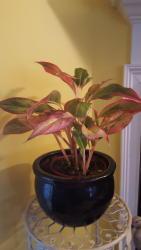Hi Kelley - I see this kind of problem all the time and it is a direct result of unnecessary and incorrect repotting. Plants prefer to be kept to quite potbound. Only when they are drying out every few days after a through watering are they in need of a larger pot. The larger pot should be only one size larger and must have drain holes. The original rootball should be left intact and that soil not removed or replaced. Doing so, damages the tiny roothairs that do most of the work. When repotting, you must use a potting mix that is compatible with the mix that it was grown in. So, there is much that can go wrong when repotting is attempted.
If you are repotting because you find the plastic nursery pot unattractive, then simply set that plastic pot inside of a nicer looking planter. That way the roots are left undisturbed.
The new pot for your Aglaonema is much too large for the plant. Some of the roots may have been damaged during the repotting and other roots may be starting to rot because all of the soil in the root zone is keeping oxygen away from the roots. When roots are damaged, the plant reacts by sacrificing its older leaves.
I suggest that you remove any soil that you added to the top of the original rootball when you repotted. That soil serves no useful purpose and it is keeping the soil deeper in the pot from drying out properly. After removing that soil, allow the top quarter of the remaining soil to dry before adding any water. Then, add just enough water so that it reaches that same level of dryness again in about a week. In the interim, remove all dead and dying leaves as they will not recover.
Good luck!

